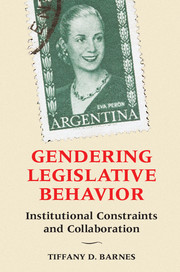Book contents
- Frontmatter
- Dedication
- Contents
- List of Tables
- List of Figures
- Acknowledgments
- 1 Introduction
- 2 A Theory of Legislative Collaboration
- 3 Can Democracy Be Collaborative? Examining Patterns of Collaboration
- 4 Why Do Women Collaborate? Evidence of Women's Marginalization
- 5 When Do Women Collaborate? Explaining Between-Chamber Variation
- 6 When Do Women Collaborate? Explaining Within-Chamber Variation
- 7 Collaboration in a Cross-National Context
- 8 Conclusion
- References
- Index
6 - When Do Women Collaborate? Explaining Within-Chamber Variation
Published online by Cambridge University Press: 05 June 2016
- Frontmatter
- Dedication
- Contents
- List of Tables
- List of Figures
- Acknowledgments
- 1 Introduction
- 2 A Theory of Legislative Collaboration
- 3 Can Democracy Be Collaborative? Examining Patterns of Collaboration
- 4 Why Do Women Collaborate? Evidence of Women's Marginalization
- 5 When Do Women Collaborate? Explaining Between-Chamber Variation
- 6 When Do Women Collaborate? Explaining Within-Chamber Variation
- 7 Collaboration in a Cross-National Context
- 8 Conclusion
- References
- Index
Summary
“Women work together on legislation that affects women. Since everyone has different ideologies and perspectives, we discuss our points of view to develop legislation that better represents women.”
– Female Deputy, Río Negro, 2009In the previous chapter, I showed that factors that vary widely between legislative chambers are important for explaining when women collaborate. Patterns of collaboration also vary within chambers. For instance, many women explain that they are more likely to collaborate with female colleagues when working on women's issues legislation. When asked if women work together, a female deputy from Entre Ríos responded: “Yes, above all partisan differences. We all represent the different parties. We tend to think the same way and agree on the same things, because we believe in this process of generating and carrying out women's rights.” Similarly, in Río Negro, women look beyond partisan divisions in order to achieve common goals. As one deputy reflected, “we work together, we work with our colleagues in our party, and with other parties.”
Collaboration among women on women's issues legislation ranges from crafting legislation to participating in debates, organizing meetings, and contributing to discussions about policies. To illustrate, a female deputy explained that in Salta, legislators from all different parties get together to address women's issues. They establish relationships with women outside of the legislature to get input on the development of legislation designed to promote women's rights. When asked how women have made progress over time, she responded: “With a lot of fight and with the unification of women presenting projects in the chamber. There were women in the chamber who took charge and fought for their projects to be approved.” Women from across Argentina maintain that collaboration has important implications for women's abilities to influence the policy-making process.
In addition to women's issues legislation, I posit that other legislative contexts that vary within chambers also influence when women collaborate. Specifically, three factors that vary significantly within the Argentine legislatures should influence women's collaboration: 1) affiliation with the governor; 2) seniority status; and 3) women's issues legislation. In this chapter, I empirically investigate how these three factors structure legislative collaboration.
- Type
- Chapter
- Information
- Gendering Legislative BehaviorInstitutional Constraints and Collaboration, pp. 143 - 176Publisher: Cambridge University PressPrint publication year: 2016

